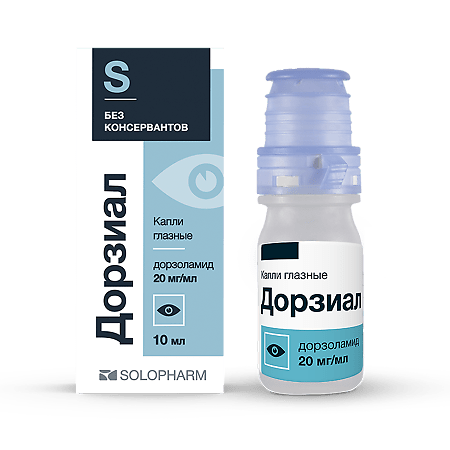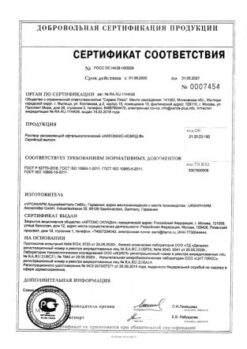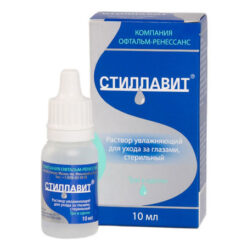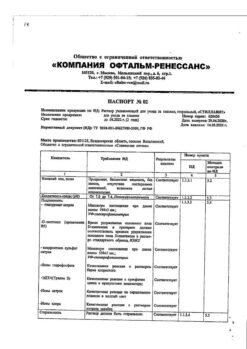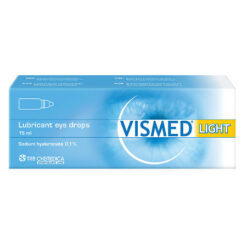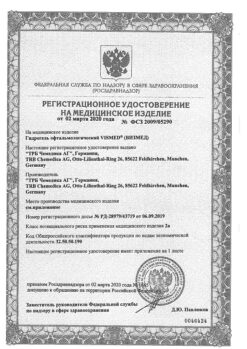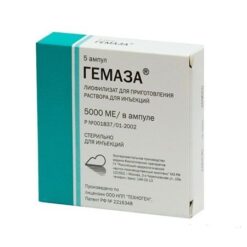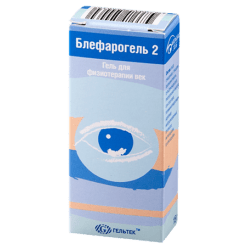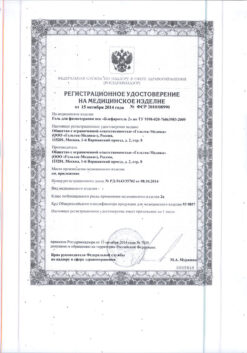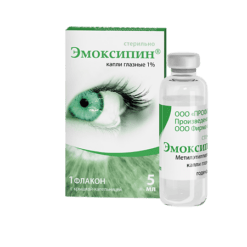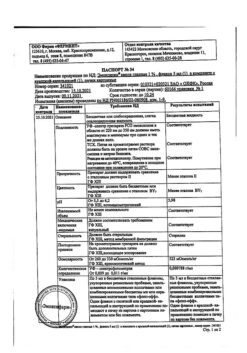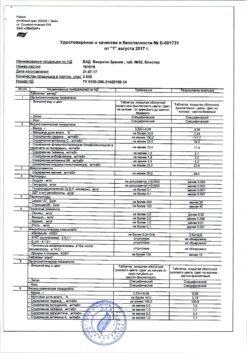No products in the cart.
Dorzial, eye drops 20 mg/ml 10 ml
€15.55 €13.47
Description
Pharmacotherapeutic group
A carboangidrase inhibitor antiglaucoma drug.
The ATX code: S01EC03
Pharmacological properties
Pharmacodynamics
Dorzolamide hydrochloride is a carboanhydrase II inhibitor.
The inhibition of carboanhydrase (CA) in the ciliary body of the eyeball reduces intraocular fluid production, presumably by slowing the synthesis of bicarbonate ions with their subsequent reduction to sodium and fluid excretion. The result is a decrease in intraocular pressure (IOP).
Pharmacokinetics
. With prolonged use, it selectively accumulates in erythrocytes as a result of selective binding to carboanhydrase II (CA-II), while the plasma concentration of free dorzolamide remains extremely low. Dorzolamide forms a single metabolite, N-dezethyl-dorzolamide, which inhibits to a lesser extent than dorzolamide the KA-II enzyme as well as the KA-I enzyme. The metabolite accumulates in erythrocytes, binding mainly to KA-I. Dorzolamide binds moderately to plasma proteins (about 33%). Dorzolamide and its metabolite are excreted mainly unchanged through the kidneys. After the end of treatment, dorzolamide is eliminated from erythrocytes unevenly, i.e. very intensively in the beginning, resulting in a rapid and significant decrease in concentration, followed by a phase of slow elimination with a half-life of about 4 months.
Indications
Indications
The drug is prescribed to adult patients with:
ophthalmic hypertension;
primary open-angle glaucoma;
pseudoexfoliative glaucoma;
secondary glaucoma (without blocking the angle of the anterior chamber of the eye).
The drug is prescribed to children:
for the treatment of glaucoma in children from 1 week of age in monotherapy or as an addition to treatment with beta-blockers.
Pharmacological effect
Pharmacological effect
Pharmacotherapeutic group
Antiglaucoma agent – carbonic anhydrase inhibitor.
ATX code: S01EC03
Pharmacological properties
Pharmacodynamics
Dorzolamide hydrochloride is a carbonic anhydrase II inhibitor.
Inhibition of carbonic anhydrase (CA) in the ciliary body of the eyeball reduces the production of intraocular fluid, presumably by slowing the synthesis of bicarbonate ions with their subsequent reduction to sodium and elimination of fluid. As a result, intraocular pressure (IOP) decreases.
Pharmacokinetics
With long-term use, it selectively accumulates in erythrocytes as a result of selective binding to carbonic anhydrase II (CA-II), while the concentration of free dorzolamide in plasma remains extremely low. Dorzolamide forms a single metabolite, N-desethyl-dorzolamide, which inhibits the KA-II enzyme to a lesser extent than dorzolamide. as well as the KA-I enzyme. The metabolite accumulates in erythrocytes, binding mainly to KA-I. Dorzolamide is moderately bound to plasma proteins (about 33%). Dorzolamide and its metabolite are excreted primarily unchanged through the kidneys. After treatment, dorzolamide is washed out of erythrocytes unevenly, that is, very intensively at the beginning, which leads to a rapid and significant decrease in concentration, followed by a slow washout phase with a half-life of about 4 months.
Special instructions
Special instructions
In old age, sensitivity to dorzolamide may increase (dose reduction required).
There are no data studying the use of the drug in patients with an acute attack of angle-closure glaucoma. It is necessary to consider the advisability of discontinuing the drug in case of allergic reactions.
If used incorrectly, ophthalmic medications can become contaminated with bacteria that cause eye diseases, which can lead to serious damage to the eye and subsequent loss of vision.
Impact on the ability to drive vehicles and machinery
When using the drug, it is not recommended to drive vehicles or engage in potentially hazardous activities that require increased concentration and speed of psychomotor reactions.
Active ingredient
Active ingredient
Dorzolamide
Composition
Composition
Active ingredient:
Dorzolamide hydrochloride 22.26 mg equivalent to dorzolamide 20.0 mg
Excipients:
Sodium citrate dihydrate 2.94 mg
Sodium hyaluronate 1.80 mg
Mannitol 23.0 mg
Sodium hydroxide solution 1 M to pH 5.6
Water for injections up to 1.0 ml
Pregnancy
Pregnancy
The use of the drug during pregnancy and breastfeeding is contraindicated.
Contraindications
Contraindications
age less than 1 week;
hypersensitivity to the components of the drug;
chronic renal failure;
pregnancy;
breastfeeding period.
With caution
The drug has not been studied in patients with severe hepatic impairment and, therefore, should be used with caution in this category of patients.
Side Effects
Side Effects
In clinical trials, dorzolamide eye drops were administered to 1,108 patients as monotherapy or add-on therapy to beta-blocker treatment. In approximately 3% of patients, the drug was discontinued due to local ocular adverse reactions, the most common being conjunctivitis and eyelid reactions.
Side effects recorded during studies and during the post-registration period are classified by frequency (very common (≥1/10); common (≥1/100, <1/10); uncommon (≥1/1000, <1/100); rare (≥1/10000, <1/1000)).
From the nervous system
Common: headache.
Rarely: dizziness, paresthesia.
From the side of the organ of vision
Very common: burning and pain.
Common: superficial punctate keratitis, lacrimation, conjunctivitis, eyelid inflammation, itching, eyelid irritation, blurred vision.
Uncommon: iridocyclitis.
Rarely: redness of the eyes, pain, hyperkeratosis of the eyelids, transient myopia (disappearing after discontinuation of the drug), corneal edema, eye hypotonia, choroidal detachment after surgery to restore the outflow of intraocular fluid.
From the respiratory organs, chest and mediastinum
Rarely: nosebleeds.
From the gastrointestinal tract
Common: nausea, bitter taste in the mouth.
Rarely: pharyngitis, dry mouth.
From the urinary tract
Rarely: urolithiasis.
From the skin and subcutaneous tissue
Rare: contact dermatitis, Stevens-Johnson syndrome, toxic epidermal necrolysis.
General disorders and disorders at the injection site
Often: asthenia, fatigue.
Rarely: allergic reactions – signs and symptoms of local reactions (from the eyelids) and systemic allergic reactions, including angioedema, urticaria, itching, rash, difficulty breathing, less commonly – bronchospasm.
Children
In a 3-month, double-blind, multicenter, active comparator study in 184 children <6 years of age, the adverse reaction profile of dorzolamide eye drops was comparable to that observed in adult patients. The most common adverse reactions associated with dorzolamide eye drops in children under 2 years of age were conjunctival injection (5.4%) and ocular discharge (3.6%). In children aged 2 to 6 years, the most common adverse reactions were burning sensation in the eye (12.1%), conjunctival injection (7.6%), and pain in the eye (3%). inflammation of the eyelids (3%).
Interaction
Interaction
No special studies have been conducted to study the interaction of Dorzial with other drugs. In clinical studies, the drug with dorzolamide in the form of eye drops was prescribed in combination with other drugs without negative manifestations of drug-drug interactions, including: timolol and betaxolol eye drops, as well as systemic drugs: angiotensin-converting enzyme (ACE) inhibitors, calcium channel blockers, diuretics, non-steroidal anti-inflammatory drugs (including acetylsalicylic acid), hormones (estrogen, insulin, thyroxine).
The possibility of mutual enhancement of the systemic effects of carbonic anhydrase inhibitors for internal use and the drug Dorzial when used simultaneously cannot be ruled out. Combination treatment with drugs that have systemic effects and local carbonic anhydrase inhibitors has not been studied in clinical studies.
Dorzial is a carbonic anhydrase inhibitor and, although applied topically, is partially absorbed and may have systemic effects. In clinical studies, the use of drugs with dorzolamide in the form of eye drops was not accompanied by a violation of the acid-base balance. However, similar phenomena were observed when using carbonic anhydrase inhibitors, including as a result of drug-drug interactions with other drugs (as a manifestation of toxicity when taking high doses of salicylates). Thus, when prescribing Dorzial, one should not forget about the possibility of such drug-drug interactions.
The patient should tell the doctor about all medications he is using or plans to use, including those sold without a prescription.
Particular attention should be paid to taking high doses of acetylsalicylic acid, as toxicity may increase.
Overdose
Overdose
Symptoms
Electrolyte disturbances, the development of metabolic acidosis and the occurrence of drowsiness, nausea, dizziness, headache, weakness, unusual dreams, and dysphagia are possible.
Treatment
Symptomatic therapy is carried out aimed at maintaining the vital functions of the body. Plasma concentrations of electrolytes (especially potassium) and blood pH values should be monitored.
Storage conditions
Storage conditions
At a temperature not exceeding 25 °C.
Keep out of the reach of children.
Shelf life
Shelf life
2 years.
Do not use after the expiration date!
Manufacturer
Manufacturer
Grotex LLC, Russia
Additional information
| Shelf life | 2 years. Do not use after the expiration date! |
|---|---|
| Conditions of storage | At a temperature not higher than 25 ° C. Keep out of reach of children. |
| Manufacturer | Grotex Ltd, Russia |
| Medication form | eye drops |
| Brand | Grotex Ltd |
Related products
Buy Dorzial, eye drops 20 mg/ml 10 ml with delivery to USA, UK, Europe and over 120 other countries.

